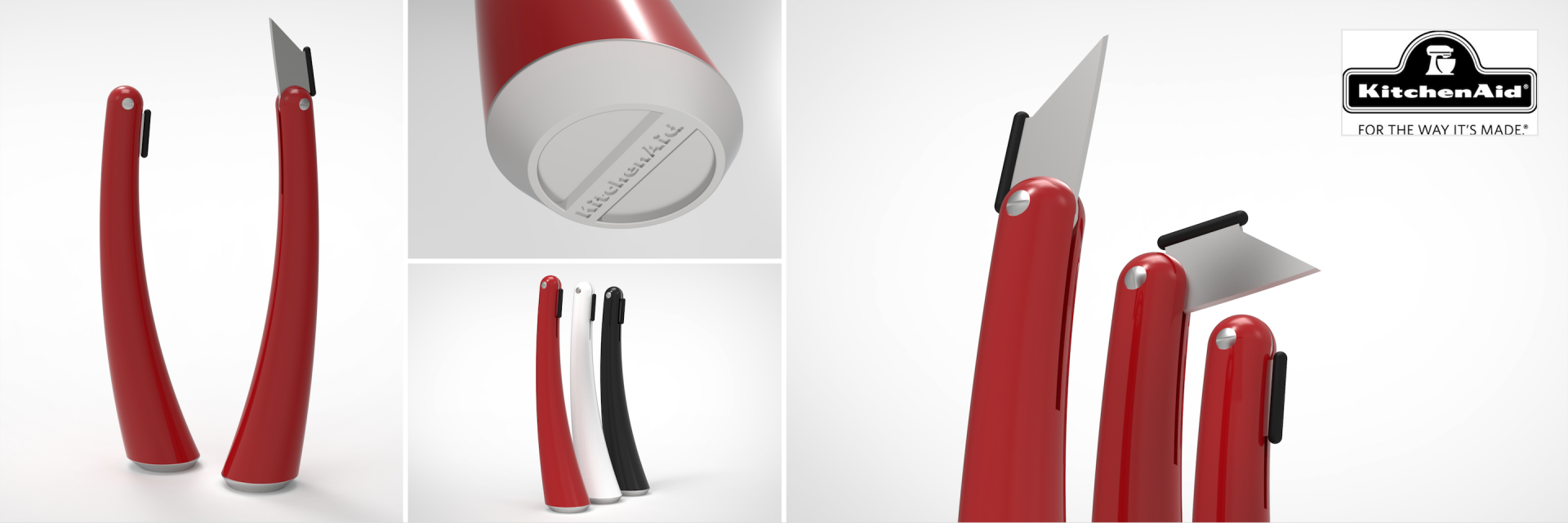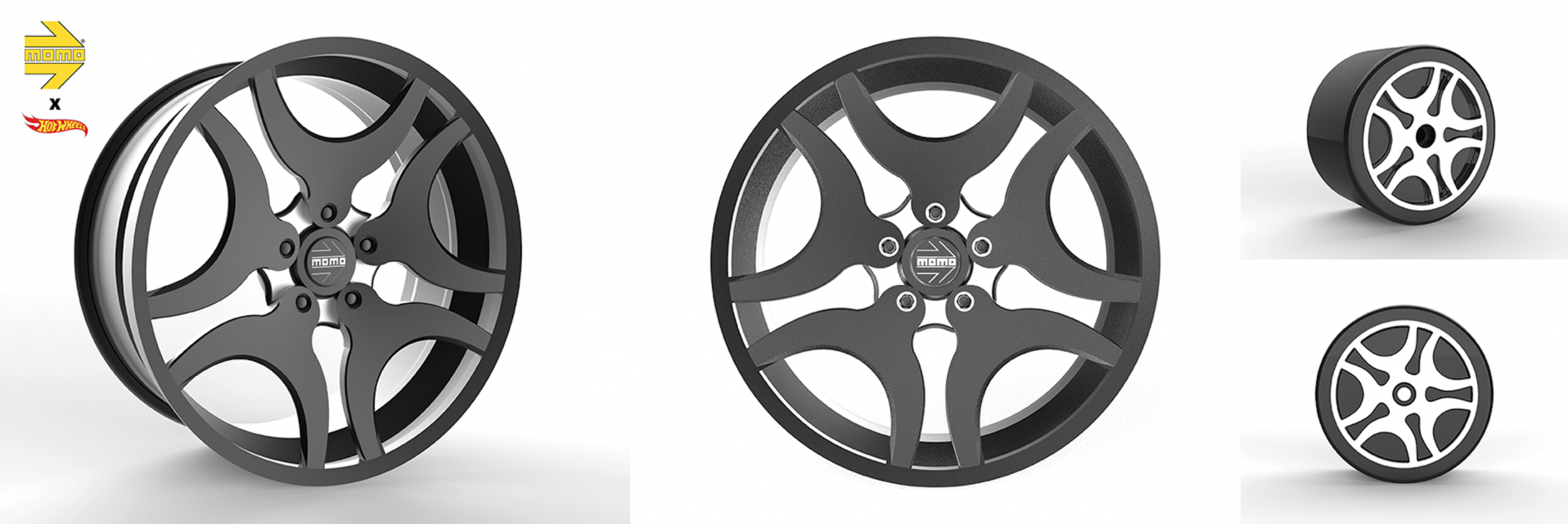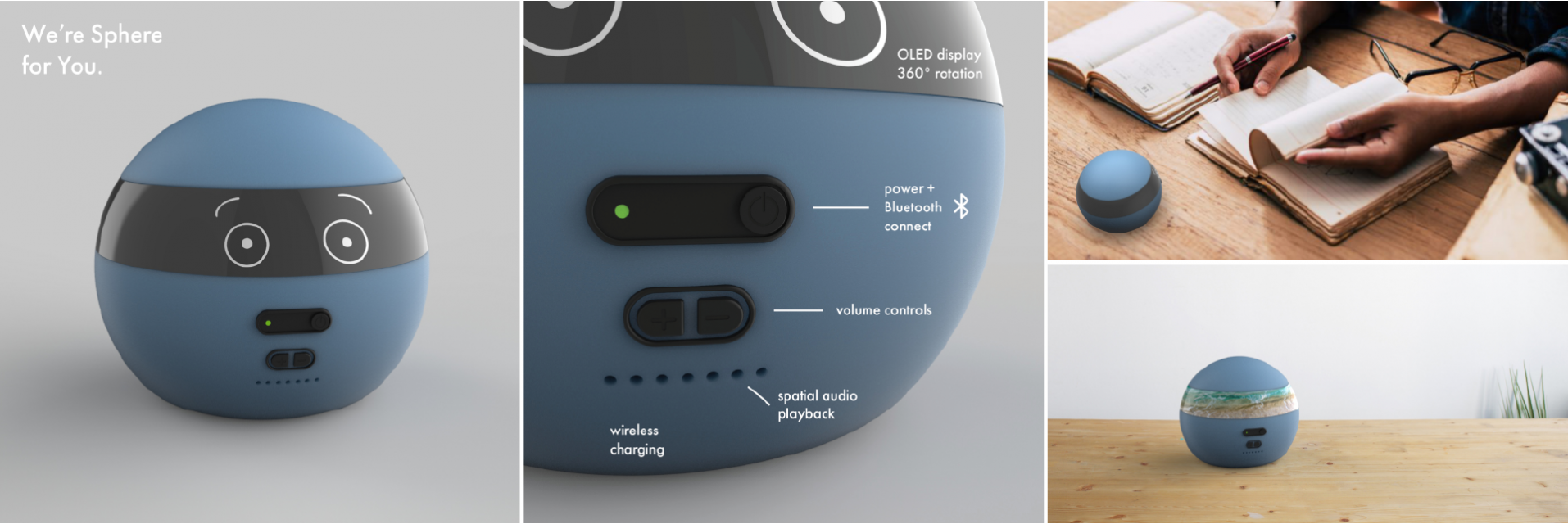
What’s In a Brand?
Teammate:
Maddie Hadd
Class: ID 3041 | Instructor: Samuel Harris
I worked with a partner to design a KitchenAid branded writing instrument. We stretched the definition of what a “writing instrument” was, and designed for what our user really needed. We asked ourselves: “If writing is seen as leaving your mark, then how does one leave their mark in the kitchen?” Our answer came in the form of the bread lame- a tool used to score dough before it is baked. Bread lames can be used to create stunning designs on artisan breads, so we designed a KitchenAid version of the tool that could enable bakers to express themselves in the kitchen- a core value that the brand itself stands for. Inspired by the iconic stand mixer, and the values of KitchenAid, we designed a lame that is both aesthetically beautiful, as well as functional, efficient, and durable. We borrowed design elements from the brand and applied them to our product- creating something that could fit right in with the KitchenAid lineup that exists today.

Variable Product Systems
Class: ID 3041 | Instructor: Samuel Harris
I designed a modular storage cube system; ideally for use by families living in tiny houses. I wanted to create a product that could help to maximize the small amount of space in a tiny family home. I achieved this by designing a product that could adapt to the users’ needs as they change; focusing on the living room, as this tends to be the part of the home where multiple people gather. I wanted to enable the user to continue to do the things they enjoy (hosting guests, spending time together in the space as a family) while not having to sacrifice the limited amount of space available to them. My modular storage cubes have the ability to replace the need for multiple pieces of furniture (a coffee table, footrest, side table, etc.) by providing a system of pieces that can work together and adapt to fill these different functions as need be.

MOMO / Hot Wheels
Class: ID 3041 | Instructor: Samuel Harris
My goal was to design an automobile wheel for Momo that reflects the brand’s visual language, while incorporating all of the necessary parts in a way that was integrated smoothly and created an interesting visual effect. I took inspiration from the vintage wheels of the Porsche 959, and gave that design a modern, MOMO twist. Based on feedback from the client throughout the various steps of the designing process, I refined my wheel to better achieve the objective that I had set for this project. // Simplifying the wheel to create the Hot Wheels version meant removing some of the detail (due to the significantly smaller scale), but I was able to retain the original wheel’s general silhouette, while still creating a wheel that is functional and manufacturable.

BeltLine Lighting
Class: Sophomore Studio | Instructor: Lisa Marks
The BeltLine is a lively hiking trail that runs through the core of Atlanta, Georgia. It is known for its sense of creative expression and art installations. Travel along the BeltLine and you will pass a flurry of bright colors, restaurants, and wildlife.
The current lighting on the BeltLine, however, lacks the charm and creative expression that people expect to see when they visit the trail. Not only is the current lighting underwhelming, but it is also very scarce, leaving large sections of the BeltLine dark at night. This is both an aesthetic and safety issue that I aim to solve with my BeltLine lighting concept.
I drew inspiration from the bright colors I saw when I visited the BeltLine, and applied this same whimsy and high-energy aesthetic to my lamp design. During the day, the blue pop of color is seen on the legs of the lamp. At night, the painted interior shines through the circle cutouts, and projects a wondrous pattern of light onto the sidewalk, while at the same time providing users with a well-lit pathway for safe travel.
Since the BeltLine is such a popular destination, even at night, the lighting there can become an important experience for users. The lighting effect that my lamp creates is intended to provide users with the unique experience that they expect when visiting such an artistic and expressive location.

Sphere for You
Class: Sophomore Studio | Instructor: Lisa Marks
University counseling centers around the country are struggling to keep up with the ever-increasing number of students who are struggling with mental health issues. This in turn makes students feel like their institutions don’t care about them, leaving them feeling ignored and unheard when they try to reach out for help that just isn’t there.
I want to help institutions prepare for future events where students may not be able to meet with a counselor in person by giving students their own tools and safe spaces to share and process their difficult emotions on their own. With the incorporation of Sy into campus counseling tactics, I predict a 5-10% decrease in the need for students to meet with a counselor individually.
Sy is intended to give students a safe space to share their emotions openly without ever feeling judged or ignored.
How it works: Sy uses facial recognition to identify a user’s emotions based on given facial expressions. It will encourage you to share how you are feeling, and then, based on your current emotional state, offer the appropriate tools to manage any difficult emotions, such as meditation techniques or breathing exercises.
Sy uses AI to reflect back to you how you are feeling - depending on your current emotional state, it will match that with the appropriate facial expression. Through this, Sy aims to forge a deeper and more meaningful connection between user and product.

Gut Em’ - Pumpkin Gutting Drill Bit
Class: Sophomore Studio | Instructor: Lisa Marks
Gut Em’ greatly reduces the work that goes into gutting a pumpkin, while bringing an exciting new experience to the tradition of jack-o-lanterns!
I soon discovered that the process of making a jack-o-lantern took a pretty deep dive during the act of scooping the pumpkin. It can become a very tedious process when only using a serrated spoon to try and separate the guts from the rind. So, I chose to focus on improving this step in the hopes that in doing so would also improve the steps that follow; thus improving the overall experience of making a jack-o-lantern.
Turning the pumpkin gutting device into a drill bit rather than a spoon relieves a lot of the work that needs to be done to gut a pumpkin, while at the same time, making the entire process a lot more fun for the user.
The gutter works by scraping the walls of the pumpkin at a very high speed; obliterating any connection the guts have to the rind. Compared to a generic pumpkin scoop, which involves about 10 minutes of very strenuous scooping for a mediocre result, the Gut Em’ drill bit wipes out the guts from the pumpkin in about 2 minutes, leaving only 1 minute of easy scooping for the user.
